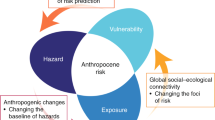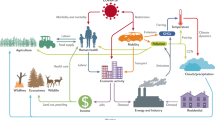Abstract
The planetary boundary framework presents a ‘planetary dashboard’ of humanity’s globally aggregated performance on a set of environmental issues that endanger the Earth system’s capacity to support humanity. While this framework has been highly influential, a critical shortcoming for its application in sustainability governance is that it currently fails to represent how impacts related to one of the planetary boundaries affect the status of other planetary boundaries. Here, we surveyed and provisionally quantified interactions between the Earth system processes represented by the planetary boundaries and investigated their consequences for sustainability governance. We identified a dense network of interactions between the planetary boundaries. The resulting cascades and feedbacks predominantly amplify human impacts on the Earth system and thereby shrink the safe operating space for future human impacts on the Earth system. Our results show that an integrated understanding of Earth system dynamics is critical to navigating towards a sustainable future.
This is a preview of subscription content, access via your institution
Access options
Access Nature and 54 other Nature Portfolio journals
Get Nature+, our best-value online-access subscription
$29.99 / 30 days
cancel any time
Subscribe to this journal
Receive 12 digital issues and online access to articles
$119.00 per year
only $9.92 per issue
Buy this article
- Purchase on Springer Link
- Instant access to full article PDF
Prices may be subject to local taxes which are calculated during checkout





Similar content being viewed by others
Data availability
All data used in the manuscript’s analyses are available in the Supplementary Information (Supplementary Tables 1 and 2).
Code availability
All computations are fully described in Methods. Implementation in R of these computations is available upon request.
References
Steffen, W. et al. Planetary boundaries: guiding human development on a changing planet. Science 347, 1259855 (2015).
Rockström, J. et al. Planetary boundaries: exploring the safe operating space for humanity. Ecol. Soc. 14, 32 (2009).
Downing, A. S. et al. Matching scope, purpose and uses of planetary boundaries science. Environ. Res. Lett. 14, 073005 (2019).
Brook, B. W., Ellis, E. C., Perring, M. P., Mackay, A. W. & Blomqvist, L. Does the terrestrial biosphere have planetary tipping points? Trends Ecol. Evol. 28, 396–401 (2013).
Montoya, J. M., Donohue, I. & Pimm, S. L. Planetary boundaries for biodiversity: implausible science, pernicious policies. Trends Ecol. Evol. 33, 71–73 (2018).
German Sustainable Development Strategy (Die Bundesregierung, 2016).
Griggs, D. et al. Sustainable Development Goals for people and planet. Nature 495, 305–307 (2013).
Anderies, J. M., Carpenter, S. R., Steffen, W. & Rockström, J. The topology of non-linear global carbon dynamics: from tipping points to planetary boundaries. Environ. Res. Lett. 8, 044048 (2013).
Heck, V., Donges, J. F. & Lucht, W. Collateral transgression of planetary boundaries due to climate engineering by terrestrial carbon dioxide removal. Earth Syst. Dyn. 7, 783–796 (2016).
Heck, V., Hoff, H., Wirsenius, S., Meyer, C. & Kreft, H. Land use options for staying within the Planetary Boundaries — synergies and trade-offs between global and local sustainability goals. Glob. Environ. Change 49, 73–84 (2018).
Heck, V., Gerten, D., Lucht, W. & Popp, A. Biomass-based negative emissions difficult to reconcile with planetary boundaries. Nat. Clim. Change 8, 151–155 (2018).
Heck, V., Gerten, D., Lucht, W. & Boysen, L. R. Is extensive terrestrial carbon dioxide removal a ‘green’ form of geoengineering? A global modelling study. Glob. Planet. Change 137, 123–130 (2016).
Friedrich, J. Modeling for Planetary Boundaries: A Network Analysis of the Representations of Complex Human–Environmental Interactions in Integrated Global Models. MSc thesis, Linköping Univ. (2013).
Griggs, D., Nilsson, M., Stevance, A.-S. & McCollum, D. A Guide to SDG Interactions: From Science to Implementation (International Council for Science, 2017).
Nilsson, M. et al. Mapping interactions between the Sustainable Development Goals: lessons learned and ways forward. Sustain. Sci. 13, 1489–1503 (2018).
Pradhan, P., Costa, L., Rybski, D., Lucht, W. & Kropp, J. P. A systematic study of Sustainable Development Goal (SDG) interactions. Earths Future 5, 1169–1179 (2017).
Jägermeyr, J., Pastor, A., Biemans, H. & Gerten, D. Reconciling irrigated food production with environmental flows for Sustainable Development Goals implementation. Nat. Commun. 8, 15900 (2017).
Independent Group of Scientists appointed by the Secretary-General Global Sustainable Development Report 2019: The Future Is Now – Science for Achieving Sustainable Development (United Nations, 2019).
Donges, J. F. et al. Closing the loop: reconnecting human dynamics to Earth system science. Anthropocene Rev. 4, 151–157 (2017).
Nash, K. L. et al. Planetary boundaries for a blue planet. Nat. Ecol. Evol. 1, 1625–1634 (2017).
Schellnhuber, H. J. ‘Earth system’ analysis and the second Copernican revolution. Nature 402, C19–C23 (1999).
Lenton, T. Earth System Science: A Very Short Introduction (Oxford Univ. Press, 2016).
Hu, Y. Efficient, high-quality force-directed graph drawing. Math. J. 10, 37–71 (2006).
Pasztor, J., Scharf, C. & Schmidt, K.-U. How to govern geoengineering? Science 357, 231 (2017).
Foley, J. A. et al. Global consequences of land use. Science 309, 570–574 (2005).
Orr, S., Pittock, J., Chapagain, A. & Dumaresq, D. Dams on the Mekong River: lost fish protein and the implications for land and water resources. Glob. Environ. Change 22, 925–932 (2012).
Sterner, T. et al. Policy design for the Anthropocene. Nat. Sustain. 2, 14–21 (2019).
Rockström, J. et al. A safe operating space for humanity. Nature 461, 472–475 (2009).
Steffen, W. et al. Trajectories of the Earth system in the anthropocene. Proc. Natl Acad. Sci. USA 115, 8252–8259 (2018).
Rinkevich, B. Rebuilding coral reefs: does active reef restoration lead to sustainable reefs? Curr. Opin. Environ. Sustain. 7, 28–36 (2014).
Søndergaard, M., Jeppesen, E. & Jensen, H. S. in Encyclopedia of Lakes and Reservoirs (eds Bengtsson, L. et al.) 455–458 (Springer, 2012).
Clarke, L. et al. in Climate Change 2014: Mitigation of Climate Change (eds Edenhofer, O. et al.) Ch. 6 (IPCC, Cambridge Univ. Press, 2014).
Fajardy, M. & Mac Dowell, N. Can BECCS deliver sustainable and resource efficient negative emissions? Energy Environ. Sci. 10, 1389–1426 (2017).
Harper, A. B. et al. Land-use emissions play a critical role in land-based mitigation for Paris climate targets. Nat. Commun. 9, 2938 (2018).
Springmann, M. et al. Options for keeping the food system within environmental limits. Nature 562, 519–525 (2018).
Willett, W. et al. Food in the Anthropocene: the EAT–Lancet Commission on healthy diets from sustainable food systems. Lancet 393, 447–492 (2019).
Cooper, G. S. & Dearing, J. A. Modelling future safe and just operating spaces in regional social-ecological systems. Sci. Total Environ. 651, 2105–2117 (2019).
Hossain, M. S., Dearing, J. A., Eigenbrod, F. & Johnson, F. A. Operationalizing safe operating space for regional social-ecological systems. Sci. Total Environ. 584–585, 673–682 (2017).
Dearing, J. A. et al. Safe and just operating spaces for regional social-ecological systems. Glob. Environ. Change 28, 227–238 (2014).
Mantyka-Pringle, C. S. et al. Climate change modifies risk of global biodiversity loss due to land-cover change. Biol. Conserv. 187, 103–111 (2015).
Raworth, K. A safe and just space for humanity: can we live within the doughnut? Oxfam Policy Pract. Clim. Change Resil. 8, 1–26 (2012).
Messerli, P. et al. Expansion of sustainability science needed for the SDGs. Nat. Sustain. 2, 892–894 (2019).
Nilsson, M., Griggs, D. & Visbeck, M. Policy: map the interactions between sustainable development goals. Nature 534, 320–322 (2016).
Heistermann, M. A planetary boundary on freshwater use is misleading. Hydrol. Earth Syst. Sci. 21, 3455–3461 (2017).
Lewis, S. L. We must set planetary boundaries wisely. Nature 485, 417 (2012).
Galaz, V. Planetary boundaries concept is valuable. Nature 486, 191 (2012).
Rockström, J., Richardson, K., Steffen, W. & Mace, G. Planetary boundaries: separating fact from fiction. A response to Montoya et al. Trends Ecol. Evol. 33, 233–234 (2018).
Carpenter, S. R. & Bennett, E. M. Reconsideration of the planetary boundary for phosphorus. Environ. Res. Lett. 6, 014009 (2011).
Scientific Assessment of Ozone Depletion: 2018. Executive Summary (World Meteorological Organization, 2018).
Engelberg, S. A Mathematical Introduction to Control Theory (Series in Electrical and Computer Engineering) Vol. 4 (Imperial College Press, 2005).
Anderies, J. M., Rodriguez, A. A., Janssen, M. A. & Cifdaloz, O. Panaceas, uncertainty, and the robust control framework in sustainability science. Proc. Natl Acad. Sci. USA 104, 15194–15199 (2007).
Harrison, I. et al. The freshwater biodiversity crisis. Science 362, 1369 (2018).
Aleksandrowicz, L., Green, R., Joy, E. J. M., Smith, P. & Haines, A. The impacts of dietary change on greenhouse gas emissions, land use, water use, and health: a systematic review. PLoS ONE 11, e0165797 (2016).
Gu, Z., Gu, L., Eils, R., Schlesner, M. & Brors, B. circlize implements and enhances circular visualization in R. Bioinformatics 30, 2811–2812 (2014).
Acknowledgements
The research leading to these results has received funding from the European Research Council Advanced Investigator project ‘Earth Resilience in the Anthropocene’ (grant ERC-2016-ADG-743080), the Swedish Research Council Formas (grant 2014-589), the Earth League’s Earth Doc programme, a Royal Society University Research Fellowship, Velux/KR Foundation (FP-1503-01714) and the UK Natural Environment Research Council (grant NE/R010811/1). We thank S. Cornell and R. Trebilco for their comments on drafts of the manuscript.
Author information
Authors and Affiliations
Contributions
S.J.L. and W.S. conceived the study. S.J.L., W.S. and W.d.V. developed the paper’s methodology. All authors contributed to the survey of literature. S.J.L. performed the modelling. S.J.L. and J.F.D. contributed to graphical representation of results. S.J.L. led the writing of the paper. All authors contributed to editing the paper.
Corresponding author
Ethics declarations
Competing interests
The authors declare no competing interests.
Additional information
Publisher’s note Springer Nature remains neutral with regard to jurisdictional claims in published maps and institutional affiliations.
Supplementary information
Supplementary information
Supplementary Tables 1–3 and methods.
Rights and permissions
About this article
Cite this article
Lade, S.J., Steffen, W., de Vries, W. et al. Human impacts on planetary boundaries amplified by Earth system interactions. Nat Sustain 3, 119–128 (2020). https://doi.org/10.1038/s41893-019-0454-4
Received:
Accepted:
Published:
Issue Date:
DOI: https://doi.org/10.1038/s41893-019-0454-4
This article is cited by
-
Optimal water resource allocation considering virtual water trade in the Yellow River Basin
Scientific Reports (2024)
-
Physical and virtual water transfers in China and their implication for water planetary boundary
Environmental Science and Pollution Research (2024)
-
Identifying leverage points for sustainable nutrient policy integration in Canada
Ambio (2024)
-
Translating Earth system boundaries for cities and businesses
Nature Sustainability (2024)
-
Notable shifts beyond pre-industrial streamflow and soil moisture conditions transgress the planetary boundary for freshwater change
Nature Water (2024)



